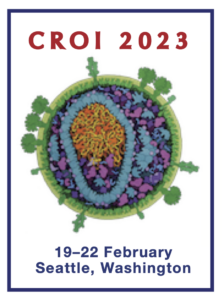CROI 2023: Similar PK profile for thigh vs gluteal CAB/RPV-LA injections: accidental intravenous injection
10 March 2023. Related: Conference reports, Antiretrovirals, CROI 30 Seattle 2023.
 CROI 2023 included a sub-study of the phase 3 ATLAS-2M study showing similar PK and safety profiles for thigh compared to gluteal intramuscular (IM) injections. [1]
CROI 2023 included a sub-study of the phase 3 ATLAS-2M study showing similar PK and safety profiles for thigh compared to gluteal intramuscular (IM) injections. [1]
Currently, CAB/RPV-LA is only approved as IM injections into the buttocks, but last year a study in HIV negative volunteers reported the potential to use the thigh as an injection site. [2]
Overall, preference remained for gluteal (60%) rather than thigh (30%) injections but these data may support injection site rotation or provide alternatives for those with contraindications.
Participants in this sub-study received a total of four (Q4W) or two (Q8W) thigh injections to maintain existing treatment schedule. The study compared PK parameters from thigh injections given for the first 16 weeks to using gluteal injections from weeks 16 to 24.
Plasma Cmin levels of CAB and RPV remained above the IC90 concentration throughout the study. PK parameters were comparable for thigh and gluteal injections, supporting use of the lateral thigh as an alternative IM site.
Thigh injections were preferred by 30% of participants who cited increased convenience and being less bothered by pain during and after dosing. However, 60% of participants preferred gluteal injections, as they either did not experience muscular pain or stiffness when walking, or were less bothered by this.
People living with HIV were enrolled into the Q4W (n=54) or Q8W (n=64) arms, median age was 48 (IQR: 24 to 71), 38% were women, 15% were Black and 9% were Hispanic/Latinx, median BMI was 25.4 (Range: 17.8 to 52.6).
There were no serious AEs and the majority of AEs were ISR-related.
One participant in the Q8W thigh group had significantly elevated plasma CAB of 60.9 ug/mL 2-hours post-dose. Levels >22.5 ug/mL were pre-defined as high. This ‘was likely’ to have been from injecting into a vein rather than muscle but drug levels immediately after the injection must have been considerably higher. The RPV injection seven minutes after CAB produced normal levels.
AEs for this participant included a choking sensation, feeling hot, and flushing within seconds of the CAB-LA injection and these were judged grade 1. They continued on the study.
comment
If approved, this alternative injection site will offer a choice, that in this study, a significant minority of people preferred.
It also overcomes situations where gluteal injections are contraindicated, for example having buttock implants.
The example from the missed injection site was only highlighted because it was within a research setting. This was reported as a ‘partial’ intravenous injection because the gauge of the needle (gauge 23 = 0.642 mm diameter) is large than the width of an arteriole/capillary/venule/vein (diameter = 10 to 50 μm). If a bigger vein is accidentally hit, the bevel of the needle would still be partially outside and only a proportion of the dose would enter the venule/vein [ViiV, personal communication].
The early high plasma levels did not cause symptoms, but the study did not report or comment on the impact on other PK parameters over the full dose period. These drugs depend on slow release from muscle and the AUC and Cmin levels must also have been affected.
However, although not published, trough levels after eight weeks were still within the therapeutic range due to ongoing absorption from previous injections [personal communication]. The accidental injection was at week 8 of the sub-study [personal communication].
There is little data on implications of accidentally missing the muscle for these injections but this might also be complicated by the wide interpatient variability of subcutaneous fat. [3]
Although Q8W dosing is approved and the most widely used, the poster includes a useful reminder of the generally more constant drug levels from Q4W injections and the greater interpatient variability with Q8W dosing (see Figure 2).
An oral presentation by Jean-Michel Molina and colleagues from a separate PK study in 49 participants reported that trough levels were often below target thresholds in a significant percentage of people. This included 61% and 81% of cabotegravir levels and 28% and 27% of rilpivirine levels being below the target at weeks 4 and 12 respectively. Viral rebound was reported in one participant with low drug levels of both drugs. [4]
In contrast, cabotegravir levels remained considerably higher than target levels for PrEP in African women who were late for repeat injections, with this study concluding that dosing every three months might be possible. [5]
References
- Felizarta F et al. Thigh injections of cabotegravir and rilpivirine in virally suppressed adults with HIV-1. CROI 2023, Seattle. Poster Abstract 519.
https://www.croiconference.org/abstract/thigh-injections-of-cabotegravirrilpivirine-in-virally-suppressed-adults-with-hiv-1 (abstract)
https://www.croiconference.org/wp-content/uploads/sites/2/posters/2023/CROI2023_A2M_thigh_PK_poster_10Feb2023_V7-133208467269416831.pdf (poster via login) - Taylor K. Early data on injecting CAB/RPV-LA into thigh muscle. HTB (03 August 2022).
https://i-base.info/htb/43560 - Dayananda et al. Intended intramuscular gluteal injections: Are they truly intramuscular? J Postgrad Med. 2014:60.175-8. DOI:10.4103/0022-3859.132334.
https://pubmed.ncbi.nlm.nih.gov/24823517 - Molina JM et al. Low concentrations of long-acting cabotegravir and rilpivirine in patients with HIV. CROI 2023, Seattle. Oral abstract 195.
https://www.croiconference.org/abstract/low-concentrations-of-long-acting-cabotegravir-and-rilpivirine-in-patients-with-hiv/ (abstract) - Marzinke M et al. Cabotegravir pharmacology in the background of delayed injections in HPTN 084. CROI 2023, Seattle. Oral abstract 159.
https://www.croiconference.org/abstract/cabotegravir-pharmacology-in-the-background-of-delayed-injections-in-hptn-084 (abstract)
This report was first published on 7 March 2023. Additional comments were included on 2 May 2023 based on additional information on this case.

